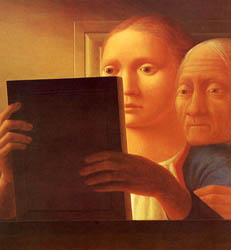Magic Realism in the Americas - Part 2

|
Three artists established a
lifelong friendship in the 1940s and individually, as well as a
group, made a strong contribution to the development on Magic Realism in
 the
United States. They are Jared French,
Paul Cadmus and George Tooker.
French introduced the other two to the Old Masters technique of using egg
tempera. Many of the early paintings of Cadmus are highly energized
and drew strong reaction for being overtly suggestive. It was
George Tooker, however, who picked up the themes of alienation and
anxiety and portrayed his world of New York City them in eerie ways, reminiscent of Neue Sachlichkeit.
Subway (1950) and Government Bureau
(1956) are exemplary. He remained wedded faithfully to Magic Realism
during his entire career and produced a very compelling body of
work. the
United States. They are Jared French,
Paul Cadmus and George Tooker.
French introduced the other two to the Old Masters technique of using egg
tempera. Many of the early paintings of Cadmus are highly energized
and drew strong reaction for being overtly suggestive. It was
George Tooker, however, who picked up the themes of alienation and
anxiety and portrayed his world of New York City them in eerie ways, reminiscent of Neue Sachlichkeit.
Subway (1950) and Government Bureau
(1956) are exemplary. He remained wedded faithfully to Magic Realism
during his entire career and produced a very compelling body of
work.
Other Americans
associated with Magic Realism
during the 1930s and
40s are Ivan Albright, Philip Evergood,
O. Louis Gugliemi,
Charles Rain and
Peter Blume. Albright developed an idiosyncratic style in later years,
but
his early work is typical of Magic Realism. Evergood and
Gugliemi produced work that had strong elements of fantasy, and
in styles that border on surrealism. Some of Blume's works are
unquestionably surrealistic, but he also produced many works of Magic
Realism.
There are many writers who include Andrew Wyeth
 as a Magic
Realist. Wyeth is a master of the dry brush and egg tempera techniques which allowed
him to achieve great detail in his work. Certainly the strong
feeling of nostalgia and rural isolation that emanates from his work helps bring a mysterious
quality to his paintings. This is combined with many unusual
viewpoints, including sharp focus in both the foreground and
background, as well as the sharp detail in his work verifies his standing as
a great master of Magic Realism . The paintings by his son,
Jamie Wyeth, particularly his earliest
works, also manifest many similar
characteristics. as a Magic
Realist. Wyeth is a master of the dry brush and egg tempera techniques which allowed
him to achieve great detail in his work. Certainly the strong
feeling of nostalgia and rural isolation that emanates from his work helps bring a mysterious
quality to his paintings. This is combined with many unusual
viewpoints, including sharp focus in both the foreground and
background, as well as the sharp detail in his work verifies his standing as
a great master of Magic Realism . The paintings by his son,
Jamie Wyeth, particularly his earliest
works, also manifest many similar
characteristics.
In addition to the artists we have mentioned from the United States,
there were many others in the Americas who worked in the with Magic Realism
style.
Included are artists like the Canadian Alex Colville,
the Argentinian
Antonio Berni (during the 1930s, 40s and
50s) and Mexicans
Emilio Bas Viaud and Gabriel Fernandez
Ledesma. One might also say that the works by Frida Kahlo and
the early works of Colombian
artist Fernando Botero are related. The mysterious elements of
Kahlo's art come from Aztec and Mexican folklore, which she infused
into a realistic style stemming from the Mexicidad, the Mexican
version of Regionalism . Kahlo painted many self-portraits, some
dressed in native costumes and jewelry, often accessorized with
parrots or monkeys. Botero, who studied the Masters in Spain
and Italy, brings us a fresh and amusing brand, utilizing inflated
bodies and stylized architecture. This more extreme Latin variety
might be called "Marvelous Realism", rich in references
from earlier works of Magic Realism, as well as from many other movements in art history.
The main era of Magic Realism art lasted from the 1920s into the 50s.
In the 1960s, a new style of realism, called both Photorealism and Hyper-Realism,
came into vogue. It provided the ultra sharp image, but without
magic or
mystery. Other styles using a mixture of realism and the imagined, Fantasy art and Sci-Fi art
in particular, have also
established themselves in the past few decades, taking up much of
the territory that at one time had been occupied by Surrealism and Magic Realism .
Our discussion
continues....

Neue Sachlichkeit Gallery
European Magic
Realism Gallery
America Magic Realism
Gallery
Chapter 1 - Magic Realism Introduction
Chapter 2 - Roots of Magic Realism
Chapter 3 - Neue Sachlichkeit Artists
Chapter 4 - Surrealism vs Magic Realism
Chapter 5 - Magic Realism in other European
countries
Chapter 6 - Magic Realism in the Americas
(1)
Chapter 7 - Magic Realism in the Americas (2)
Chapter 8 - Contemporary Magic Realism
Chapter 9 - The Future of Magic Realism
Email:
dreams@tendreams.org
|